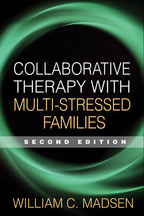Collaborative Therapy with Multi-Stressed Families
Second Edition
William C. Madsen
1. Working with Multi-Stressed Families: Recognizing the Importance of Relational Stance
2. What We See Is What We Get: Reexamining Our Assessment Process
3. Collaboration Is a Two-Way Street: Engaging Reluctant Families
4. Developing a Proactive Vision to Guide Clinical Work: Collaborative Therapy Contracts
5. Collaborative Inquiry: An Anthropological Approach to "Intervening" with Families
6. Examining the Relationship between Clients and the Problems in Their Lives
7. Helping Clients Shift Their Relationship to Problems and Develop Preferred Lives
8. Developing Communities to Support New Lives
9. Solidifying New Lives through Therapeutic Documents
10. Sustaining a Collaborative Practice in the "Real" World
Appendices: A. One Example of a Strength-Based Assessment Outline. B. Questions to Assess Externalized Problems Rather Than Families. C. Considerations in Collaborative Therapy Contracts. D. An Interview Outline to Consolidate Alternative Stories. E. Coauthoring Termination/Consolidation Summaries with Clients.



